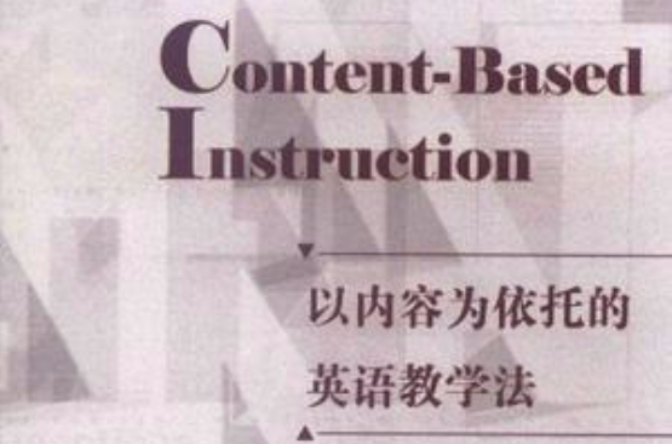《以內容為依託的英語教學法》由都建穎所著,主要目的是幫助讀者清楚準確地了解作為專門用途英語(English for Specific Purposes)的主要教學途徑之一——以內容為依託的英語教學法(CBI,即Content-Based Instruction)。
基本介紹
- 書名:以內容為依託的英語教學法
- ISBN:9787560973456
- 頁數:142頁
- 出版社:華中科技大學出版社
- 出版時間:第1版 (2011年10月1日)
- 裝幀:平裝:
- 開本:32
圖書信息,內容簡介,目錄,
圖書信息
出版社: 華中科技大學出版社; 第1版 (2011年10月1日)
外文書名: Content-Based Instruction
平裝: 142頁
正文語種: 英語
開本: 32
ISBN: 7560973450, 9787560973456
條形碼: 9787560973456
尺寸: 20 x 13.8 x 1 cm
重量: 159 g
內容簡介
作者分析並總結了該教學法的概念、理論基礎及實踐模式,認為CBI有強式與弱式之分,並且在以英語為母語和英語為外語的教學環境中有不同的教學目的和特徵;《以內容為依託的英語教學法》作者還從歷史角度闡述了CBI在中國自19世紀60年代至21世紀所經歷的三個歷史發展階段,並在介紹中國傳統教育文化的基礎上,探討了CBI在當今中國高等教育中具備的優勢以及面臨的問題。
目錄
Background
Introduction
Chapter 1 Conceptualising CBI
1.1 Definitions of CBI from a diversity of aspects
1. l. 1 A functional linguistic view of CBI
1.1.2 A pedagogical aspect of CBI
1.1.3 CBI as subset of integrated language and eontent teaching
1.2 Characteristics of GBI
1.2.1 Subject-matter eore
1.2.2 Authentic language and texts
1.2.3 Focus on specific needs of specific student groups
1.3 Towards a definition
1.3.1 Content-language integrated instruction(CLII)as the ideal form of CBI
1.3.2 Content-based language instruction (CBLI)as the weak form of CBI
1.3.3 Language-based content instruction (LBCI)as the strong form of CBI
1.4 Contextualizing CBI in EFL settings
Chapter 2 Relationship Between CBI, EAP and Other Language Teaching Approaches
2.1 CBI and EAP:the link and differences
2.1.1 CBI as an approach to EAP
2.1.2 CBI as extension of EAP
2.1.3 Common ground between CBI and EAP
2.1.4 Differences between EAP and CBI
2.2 Distinguishing CBI from other approaches and methodologies
2.2.1 Differentiating CBI from L2 content teaching
2.2.2 Differentiating CBI from bilingual education
2.2.3 CBI and the grammar-translation approach
2.2.4 CBI and the task-based approach
Chapter 3 Theoretical and Practical Supports for CBI
3.1 Theoretical support for CBI
3.1.1 Krashen's comprehensible input hypothesis
3.1.2 Swain's output hypothesis
3.1.3 Cummins' framework of language proficiency
3.1.4 O'Malley and Chamot's CALLA approach
3.2 Practical support for CBI
3.2.1 Immersion programs
3.2.2 Language across the curriculum (LAC)
3.2.3 Language for specific purposes (LSP)
Chapter 4 Advantages and Challenging Issues in CBI
4.1 Advantages of CBI
4.1.1 Teaching efficiency
4.1.2 Students' motivation
4.1.3 Learner needs
4.1.4 Opportunities for language use and usage
4.2 Challenging issues in CBI practice
4.2.1 Teacher development
4.2.2 The issue of teaching
4.2.3 The issue of assessment
Chapter 5 CBI in Higher Education in China
5.1 Education in Chinese culture
5.1.1 Teacher as academic authority
5.1.2 Highly valued academic achievement
5.1.3 Learning as a process of knowledge receiving
5.1.4 Learning as a process of thinking
5.2 CBI in China:a historical review
5.2.1 CBI in China during the Foreign Affairs Movement(Between the 1860s and the 1890s)
5.2.2 The wave of CBI since the 1980s
5.2.3 CBI in the twenty-first century
5.3 Practice of CBI in further and higher education in China
5.3.1 Course books
5.3.2 Teacher preparation
Conclusion
Bibliography

